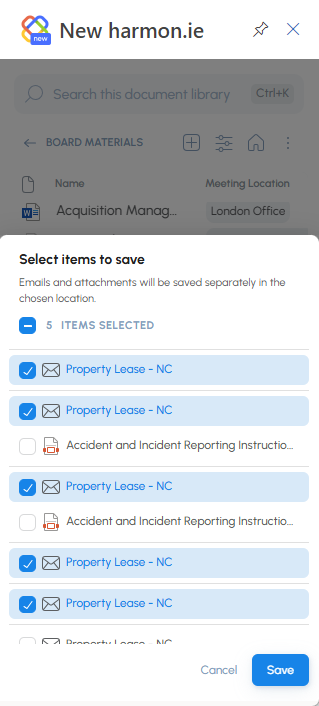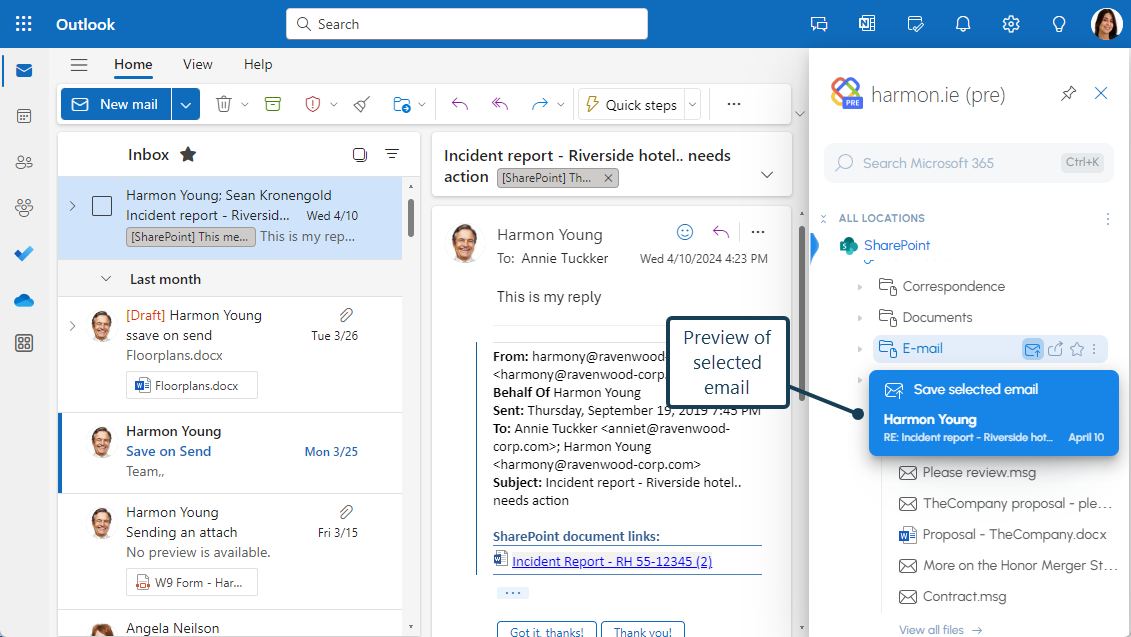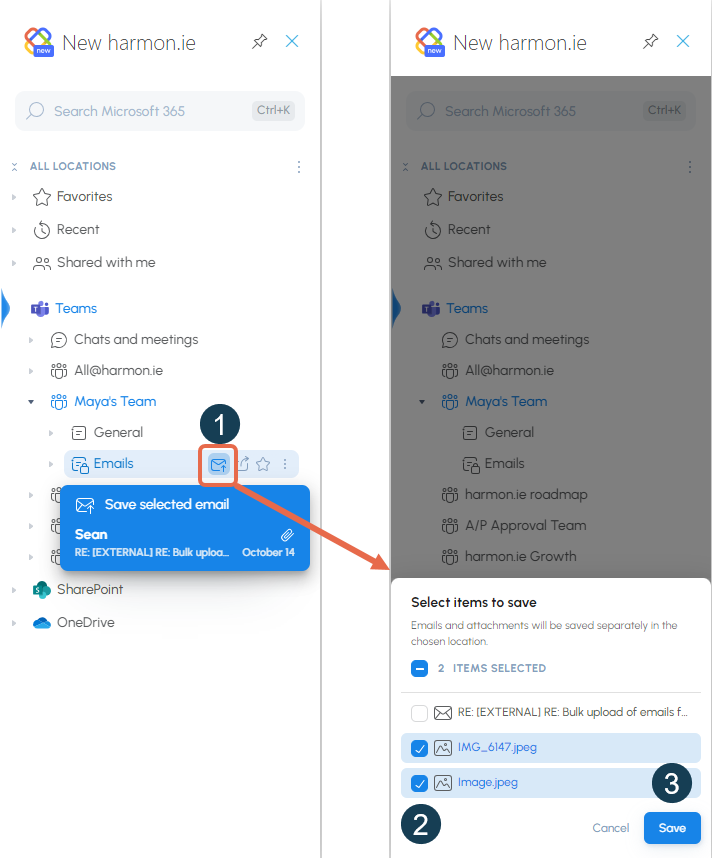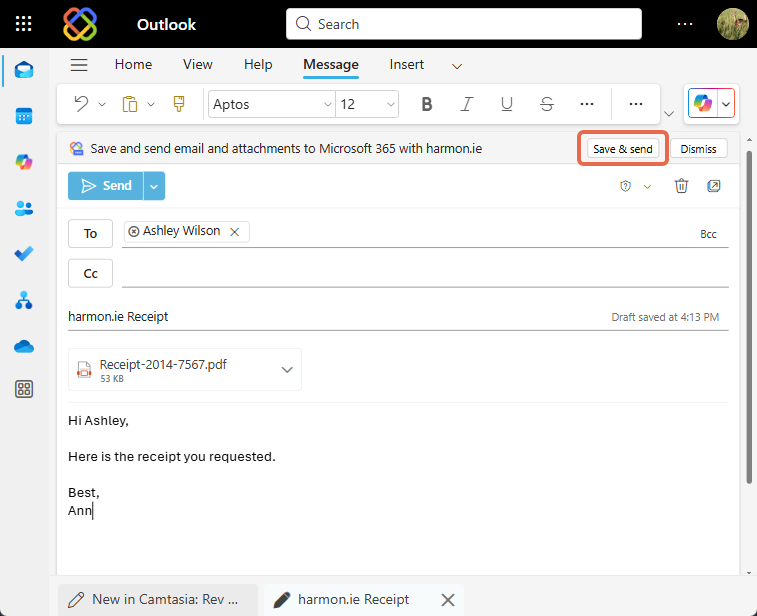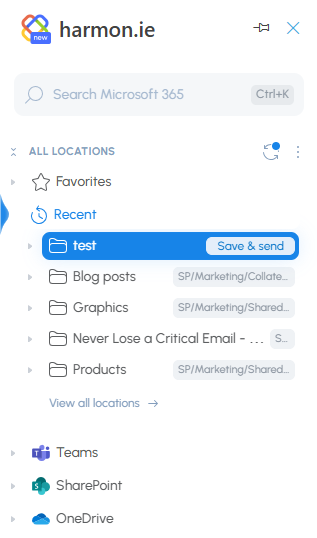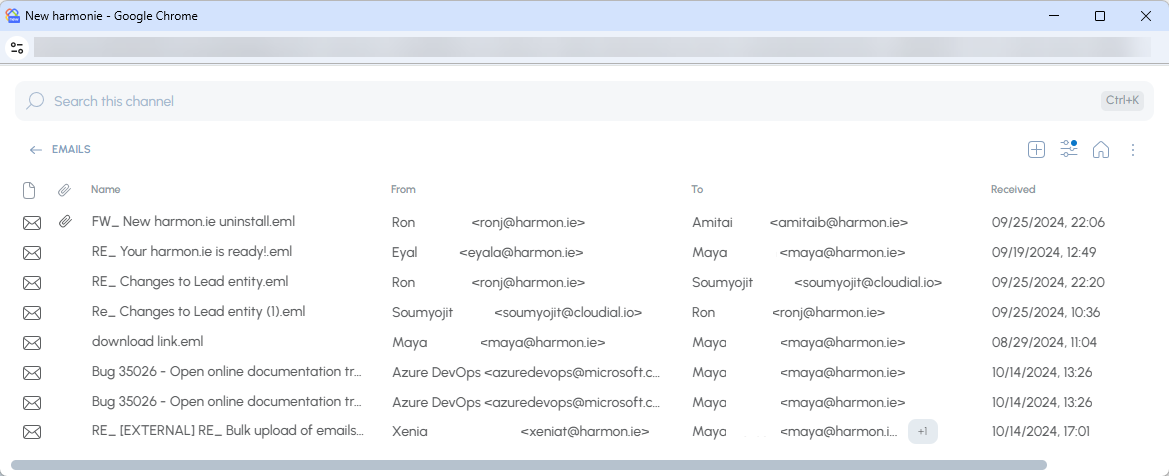Save Emails and Attachments to SharePoint, Teams, or OneDrive
This topic covers how harmon.ie helps you save Outlook emails and attachments to Microsoft 365.
In this guide, you’ll learn:
Save emails and attachments to Microsoft 365
With New harmon.ie you can:
- Save emails.
- Save email attachments with or without the email.
- Save & send: Save an email and its attachments when you send it.
Get Started
See how easy it is to save your emails to SharePoint or Teams with New harmon.ie.
How do I save an email to SharePoint, Teams, or OneDrive?
You can save an email either using drag and drop into harmon.ie or with the Save email action.
How do I save an email using drag and drop?
- In the harmon.ie sidebar, locate the SharePoint, Teams, or OneDrive location in which you want to save the email.
- Drag and drop the email to the Microsoft 365 location in the All locations view or to an area in the drill-down view. You are notified when the upload process ends.
Once uploaded, the email appears at the top of the file list. - Depending on your settings, harmon.ie may prompt to create an Email view and map email headers to SharePoint columns. Click Create view or Not now. If you don’t want to be prompted again, check Don’t ask again for this location.
- If the email was already saved to the location, you are prompted to choose whether to replace the existing email or keep both. If you select Keep both, a version number is appended to the email name.
How do I save an email using the “Save email” action?
- Open New harmon.ie.
- Select the email or emails you want to save.
- In the harmon.ie sidebar, locate the SharePoint, Teams, or OneDrive location to which you want to save the email.
- Hover over the location name and click the Save email icon (
).
Alternatively, double-click the location name to open it in the drill-down view and then click the Save email icon () at the top.
- If the email contains attachments, a dialog opens allowing you to select the attachment(s) you want to save as separate documents in the location.
- If you are saving an email thread, a dialog opens allowing you to select which emails you want to save in the location.
- Depending on your settings, harmon.ie may prompt to create an Email view and map email headers to SharePoint columns. Click Create view or Not now. If you don’t want to be prompted again, check Don’t ask again for this location.
- If the email was already saved to the location, you are prompted to select between replacing the email and keeping both. If you select Keep both, a version number is appended to the email name.
The selected email(s) are uploaded to the selected location. You are prompted to Copy link or Edit details of the uploaded email.
How do I save attachments to SharePoint, Teams, or OneDrive?
You can save attachments either with drag and drop into harmon.ie or using the Save email action.
How do I save an attachment using drag and drop?
- In the harmon.ie sidebar, locate the SharePoint, Teams, or OneDrive location in which you want to save the attachment.
- Drag and drop the attachment to the Microsoft 365 location in the All locations view or to an area in the drill-down view. You are notified when the upload process ends.
Once uploaded, the attachment appears at the top of the file list. - If the file was already saved to the location, you are prompted to select between replacing the file and keeping both. If you select Keep both, a version number is appended to the file name.
How do I save attachments using the “Save email” action?
- Open New harmon.ie.
- Select the email containing the attachment(s) you want to save.
- In the harmon.ie sidebar, locate the SharePoint, Teams, or OneDrive location to which you want to save the attachments.
- Hover over the location name and click the Save email icon (
).
Alternatively, double-click the location name to open it in the drill-down view and then click the Save email icon () at the top.
- A dialog opens allowing you to select the attachment(s) you want to save as separate documents in the location. You can uncheck the email itself if you don’t want to save it.
- If the attachment was already saved to the location, you are prompted to select between replacing the file and keeping both. If you select Keep both, a version number is appended to the file name.
How do I save and send emails with attachments?
harmon.ie lets you save emails and their attachments to SharePoint, Teams, or OneDrive when sending them, in one go.
Save & send works in two ways:
- Click the Save & send button above the recipients line to manually save and send a specific message.
- Update your settings to be prompted to save every email you send. (Admins can enable this organization-wide.)
How do I manually save and send a specific email?
If you’re not prompted automatically, you can still save and send a specific email manually:
- After composing your message, click the Save & send button at the top of the email compose window.
- The harmon.ie sidebar opens. Hover over the desired SharePoint, Teams, or OneDrive location and click Save & send.
- To save the email to a new folder, double-click the parent location to drill down, click New (
) > Folder. Hover over the new folder and click Save & send.
- If the email has attachments, choose which ones to save and click Save.
- The email and/or attachments are saved to the selected location.
- In Outlook for Windows (new) and Outlook on the Web, the email is sent automatically.
- In Outlook for Mac, you’ll need to send the email manually.
What happens when I’m prompted to save before sending?
If you or your administrator have configured harmon.ie to prompt you to save emails before sending, here’s what to expect:
- When you click Send, a dialog appears asking:
“Save this email to Microsoft 365 before sending?” - Choose one of the following options:
- Save & send – Save the email and/or attachments to a selected location.
- Send anyway – Send the email without saving anything.
- Don’t send – Cancel the action.
- If you choose Save & send:
- The harmon.ie sidebar opens. Hover over the desired SharePoint, Teams, or OneDrive location and click Save & send (or Save email in Outlook for Mac).
- To save the email to a new folder, double-click the parent location to drill down, then click New (
) > Folder. Hover over the new folder and click Save & send.
- If the email has attachments, you’ll be prompted to select which ones to save. Click Save.
- The harmon.ie sidebar opens. Hover over the desired SharePoint, Teams, or OneDrive location and click Save & send (or Save email in Outlook for Mac).
- Once the email and/or attachments are saved:
- In Outlook for Windows (new) and Outlook on the Web, the email is sent automatically.
- In Outlook for Mac, you must return to Outlook and click Send manually.
- A Microsoft 365 Admin must approve this event-based feature to make it available.
- Save & send is not available in Outlook for Windows (classic).
- In Outlook for Mac, you can save the email using harmon.ie, but you’ll need to send it manually from Outlook after saving.
Saved emails: format, metadata, categories
When you save emails to Microsoft 365 using New harmon.ie:
- Understand email format and naming.
- harmon.ie can create an Email view in the location and save email headers in SharePoint columns.
- Apply categories to saved emails in your inbox to help you recognize what was saved and where.
Saved email format and naming
harmon.ie saves your Outlook emails as .eml files in Microsoft 365 and names them automatically based on your organization’s naming settings.
Email format
New harmon.ie saves emails to Microsoft 365 in .eml format, which preserves the original formatting and metadata of the message.
Email file name
Emails are named as follows:
- By default, the email name is the email subject line.
- When you save subsequent emails with the same subject line, you are asked if you want to overwrite the email or keep both. If you keep both, a version number is appended to the email name.
- You can configure harmon.ie to give a unique name for each email, which includes the subject, sender, and date. This way when saving emails from the same thread, each will be saved as an individual file.
Email view and header mapping in SharePoint and Teams
When you save emails to Teams, harmon.ie prompts you to create an Email view in that location. You or your admin can configure harmon.ie to suggest creating an Email view for SharePoint locations as well, or cancel the prompt for all locations.
If accepted, an Email view is created in the location and the following email headers are saved in corresponding email columns:
- Has attachments – The attachment icon indicates that the email has attachments.
- Name – As explained in Email file name.
- To – Recipient names.
- From – Sender name.
- Received – Date and time when the email was received.
Selecting the Email view will display only email messages, with the email columns in a grid view.
If you save emails to a location that was pre-configured with automatic email header mapping in harmon.ie Classic, email headers will automatically be saved as metadata, without any prompt.
If a custom email header has been applied, refer your administrator to this article: Configure Custom Email Header Mapping in New harmon.ie.
Email categories in Outlook
harmon.ie applies categories to emails saved to Microsoft 365.
These categories help you quickly recognize saved emails in your inbox and understand where they were filed.
What categories you’ll see
- Saved in M365 – Indicates that the email was saved to Microsoft 365.
- Location category – Shows the exact SharePoint, Teams, or OneDrive location where the email was saved. Hover over the category to view the full path.
Why this is useful
- Instantly see which emails were saved and which still need to be filed.
- Find out where an email was saved.
- Filter your inbox to view only saved emails.
